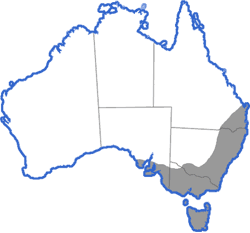Crinia signifera
Eastern Common Froglet
Also: Clicking Froglet, Common Eastern Froglet, Common Froglet, Day Frog, Varied Froglet

+ 62 kb Common Froglet (Crinia signifera)
A small ground dwelling frog, the Common Froglet is one of Eastern Australia's most common and widespread species. Its cricket-like chirping can be heard all day and all year round.
Distribution and habitat

Adults are most common in wet and dry forests, woodlands, floodplains, open and disturbed areas, and alpine grasslands. Within these habitats they shelter under logs and other debris, usually in moist depressions or near water. It is not uncommon to find dozens of individuals under one log or rock. Eggs and tadpoles are aquatic and can be found in ponds, dams, swamps, flooded grassland, ditches and hollows.
There is a detailed distribution map available for: Victoria.
Calling
Males call from among vegetation at the waters edge or floating in open water supported by vegetation. The call is a series of three to five pulsed calls, with a chirping quality, rapidly repeated in a long series - "crick crick crick crick crick".
Copyright Murray Littlejohn. Recorded by Murray Littlejohn. Must not be reproduced without permission.
Life cycle

Distinguishing characteristics

+ 49 kb The colouration of Crinia signifera is extremely variable.
Adult
length: 18-28mm.
100 - 150 pigmented eggs are usually found individually or in loose clumps, scattered around the bottom of ponds. Tadpoles are light grey or brown all over with scattered dark flecks. Adults have a granular belly which is white or muddy white, heavily mottled with black or dark brown. The patterning on the back is variable but three patterns (morphs) are recognised: [1] ridged (longitudinal ridges along back); [2] lyrate (boomerang shaped ridges over the shoulder and on the back); and [3] smooth (back smooth, unpatterned, or with small warts).
Visible features
Presented here is the information stored in the frogs.org.au database which is used to identify frogs based on their appearance. It is intended to be used in a key guide for separating species so some of the information (for example, back colours) may be rather non-specific. The system is currently being developed - if you notice errors in the data, please write to Dave Black at the address at the bottom of the page.
Important note: This information details only the appearance of the frog. If an "or" appears in the description, this may mean either that there is some variation within the species or that the feature might be observed differently by different people. For example, if a frog has very small toe pads, it may be listed as having "Toe pads: present or absent".
Size
Up to less than 30mm
Eyes, hands, and feet
Pupils: horizontal
Toe pads: absent
Webbing on feet: no webbing
Belly
Texture: rough
Pattern: marbled
Colour: multi-coloured with only black, grey, and white
Back
Texture: rough or warty or ridged
Pattern: striped or mixed / marbled
Colour: multi-coloured
Glands and tubercles
Parotoid gland: absent
Tibial gland: absent
Metatarsal tubercles: absent
Similar species (note: this version was written for Victorian species).
Members of the genus Crinia are recognisable by their bellies - granular, with mottling or peppering of dark pigment on light pigment. For differentiating between the species of Crinia, refer to the "key" (Victoria only) for the genus.
Crinia signifera image gallery
The scientific names of Crinia signifera
- Crinia (Ranidella) signifera (Girard 1853)
- Camariolus varius (Peters 1863)
- Pterophrynus verrucosus (Lutken 1863)
- Pterophrynus fasciatus (Steindachner 1867)
- Cystignathus sydneyensis (Keferstein 1867)
- Crinia stictiventris (Cope 1867)
- Crinia georgiana laevipes (Keferstein 1867)
- Camariolus pictus (Cope 1867)
- Crinia signifera englishi (Parker 1940)
- Crinia signifera montana (Parker 1940)
- Crinia affinis halmaturina (Condon 1941)
- Crinia signifera (Girard 1853)










